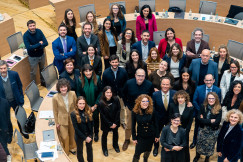Library
30 March 2025
CISUTAC's Vision for Circular EU Textiles
Library
30 March 2025
Regulation and public governance
Textile
Waste management, reuse and repair
Login / create an account to be able to react
-
2

The CISUTAC project has released a report proposing guidelines for Extended Producer Responsibility (EPR) to support the EU's transition to a circular economy. The report highlights EPR's role in reducing the environmental impact of textiles and promoting circular business models.
Topics
EU-27
Company with 250 or more employees
EU institutions
International Organisations
National authorities
SMEs (a company with less than 250 employees)
-
Transition Pathway's building blocks
-
-
Regulation and public governance
-
-
Industrial ecosystems
-
-
Textile
-
-
Textiles ecosystem areas
-
-
Waste management, reuse and repair
-
Share
Circular and Sustainable Textiles and Clothing (CISUTAC), a project dedicated to enhancing circularity and sustainability in textiles and clothing across Europe, has released a new report titled ‘CISUTAC Vision for a Circular and Sustainable EU Textile Sector: A European EPR that drives circularity’. This report proposes a set of guidelines for Extended Producer Responsibility (EPR) to support an EU-wide transition towards a circular economy.
The objective of EPR is to ensure that producers contribute to the costs of waste management and bear financial and organisational responsibility for the end-of-life phase of their products. EPR has been identified as a key element of CISUTAC's vision, as it could potentially reduce the environmental impact of textiles and promote circular business models.
Key topics covered in the report include:
• Establishment of EPR schemes tailored to widespread circularity
• Respect for the waste hierarchy
• Importance of incentivising eco-design for sustainable products
• Addressing the heterogeneity of textiles
• Development of shared responsibility and partnerships
• Ensuring uniform and effective compliance and enforcement
• Allowing sufficient time for proper implementation and stakeholder consultation
• Promoting more sustainable consumer behaviour
You can find the report attached below or consult it here.
Documents
Comments (0)
See also
-
5
CISUTAC's Vision for Circular EU Textiles
- Categories
- Textile Waste management, reuse and repair
-
5
The 2024/2025 Monitor for Circular Fashion Report
- Categories
- R&I, techniques and technological solutions Sustainable competitiveness Regulation and public governance +8 more
-
2
M4CF Circular Fashion Manifesto 2024: Best practices update
- Categories
- Skills Social dimension Sustainable competitiveness +7 more




